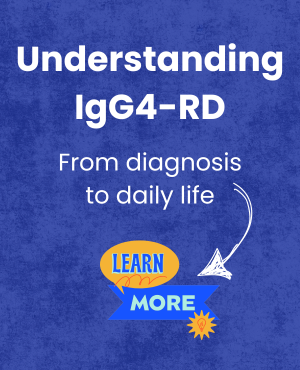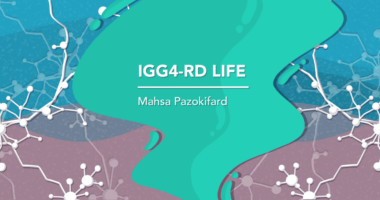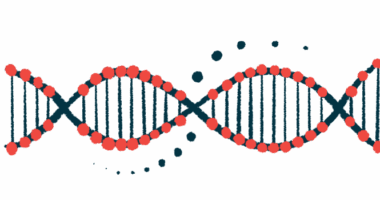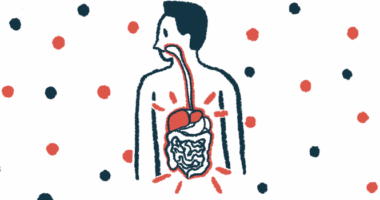IgG4-related disease symptoms
Last updated May 16, 2025, by Lindsey Shapiro, PhD

Because IgG4-related disease (IgG4-RD) is a rare immune-mediated disorder that can affect virtually any organ, symptoms can vary greatly.
While the exact IgG4-RD causes aren’t known, the disease is marked by clusters of immune cells, including plasma cells producing high amounts of an antibody called immunoglobulin G4 (IgG4), within tissues and organs. These cell aggregates cause tissue inflammation and scarring, leading to organ swelling and tumor-like masses.
The masses are not cancerous and may not initially cause any symptoms. However, organ damage can still be accruing, eventually leading to a wide range of possible IgG4-RD symptoms and complications, depending on which parts of the body are affected and to what degree inflammation and scar tissue have accumulated.
IgG4-RD is often marked by periods of worsening disease activity (relapses) interspersed with periods of general stability or symptom easing (remission). At any given time, one or multiple organs may be affected. Although the wide range of symptoms, many of them nonspecific, can delay IgG4-RD diagnosis, starting appropriate treatment early on is key to keep symptoms under control and prevent irreversible organ damage.
Main symptoms of IgG4-RD
IgG4-RD can often cause no symptoms, especially early on when there is no substantial organ damage. When symptoms do arise, it’s usually because of physical pressure or blockages from swelling or masses. Accumulation of scar tissue can also eventually irreversibly impair an organ’s usual function, driving additional symptoms.
Some general, common symptoms of IgG4-RD include unexplained weight loss and swollen lymph nodes, which are small bean-shaped structures located throughout the body and are part of the immune system. The other main IgG4-RD symptoms depend on which specific tissues or organs are involved. While any tissue can be affected, a few main clinical profiles are most typically seen.
The disease can cause pancreatitis, or inflammation in the pancreas, and sclerosing cholangitis, a condition marked by inflammation and scarring of the bile ducts, which are the tubes that transport the digestive fluid bile from the liver to the intestines. This type of involvement can cause:
- jaundice, a yellowing of the skin and whites of the eyes
- abdominal pain
- nausea
- gastrointestinal problems
- diabetes.
IgG4-RD can affect the retroperitoneum, which is the area in the back of the abdomen where several tissues and organs are located, including the kidneys. This can lead to:
- side or back pain
- urination changes or other signs of kidney issues.
When structures in the head and neck are affected, symptoms may include:
- painless but noticeable swelling in the face, salivary glands, or eyelids
- bulging of the eyes
- pain when moving the eyes
- mild dry eyes or mouth (also known as sicca).
If IgG4-RD impacts the lungs, symptoms could include:
- cough
- shortness of breath
- chest pain when inhaling.
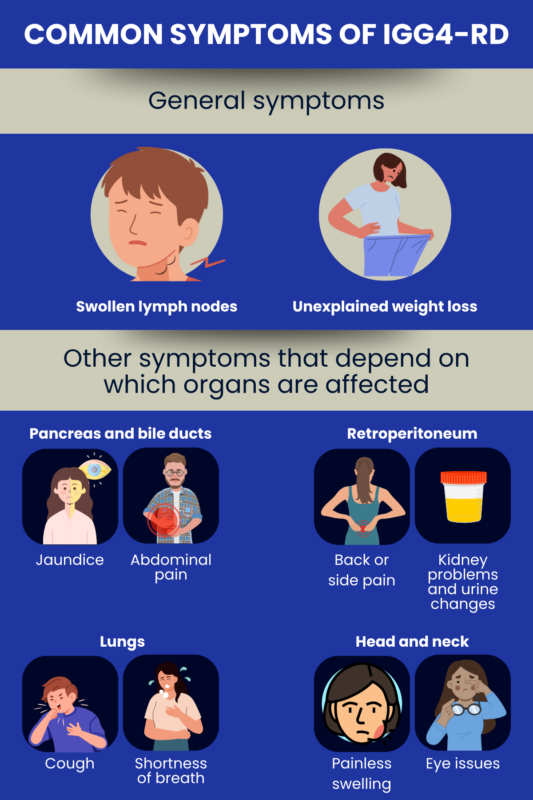
Less common symptoms of IgG4-RD
Because IgG4-RD is a systemic, or body-wide, condition that can affect virtually any organ or tissue, there are a variety of other possible symptoms, such as:
- headaches, sensory changes, general malaise, loss of appetite, or rare complications like seizures or stroke-like symptoms due to neurological involvement
- gastrointestinal problems when the disease affects the digestive tract, such as the stomach or the intestines
- thyroid problems
- mild, gradual fatigue
- bumps, nodules, or thickened patches due to skin involvement
- mild fever, which has been reported in some patients with chest involvement.
Other rare symptoms of IgG4-RD may occur if the disease affects tissues such as the prostate or sinuses (air-filled cavities around the nose).
Early signs of IgG4-RD to look out for
IgG4-RD develops slowly and can cause serious organ damage before symptoms are obvious, which can make it hard to diagnose at an early stage. Early signs of IgG4-RD can be subtle and intermittent, and may include:
- painless and mild swelling, especially around the face and eyes, or in lymph nodes in the neck, armpits, or groin
- jaundice
- gastrointestinal problems
- side or back pain
- unexplained weight loss
- shortness of breath.
However, these symptoms are nonspecific and can be indicative of other conditions, including serious ones such as cancer and liver disease. Healthcare providers need to know as soon as any of these signs of IgG4-RD are noticed so they can run tests to figure out what’s causing them.
How IgG4-RD symptoms can mimic other conditions
IgG4-RD symptoms often mimic those seen in other conditions, which can make it particularly difficult to diagnose. Those other conditions include:
- cancer, such as pancreatic cancer or lymphoma (a type of blood cancer)
- other autoimmune and inflammatory diseases, such as Sjögren’s syndrome, sarcoidosis, primary sclerosing cholangitis, granulomatosis with polyangiitis, multicentric Castleman disease, and others
- infections such as hepatitis C and HIV.
Careful consideration of a person’s entire symptom profile, along with a range of clinical and lab tests, will help doctors reach the right diagnosis and allow IgG4-RD treatment to be started as soon as possible. With appropriate care, serious organ harm can be avoided, and IgG4-RD life expectancy may be similar to what’s seen in the general population.
IgG4-related Disease News is strictly a news and information website about the disease. It does not provide medical advice, diagnosis, or treatment. This content is not intended to be a substitute for professional medical advice, diagnosis, or treatment. Always seek the advice of your physician or other qualified health provider with any questions you may have regarding a medical condition. Never disregard professional medical advice or delay in seeking it because of something you have read on this website.
Recent Posts
- A chiropractor’s functional approach provides relief from my spine issues
- Genome study finds new genetic risk factors predicting IgG4-RD
- Rare IgG4-related GI disease often mistaken for stomach tumors
- With IgG4-RD, disease remission is a process toward progress
- Autoimmune conditions seen in 1 in 10 IgG4-RD patients: Study
